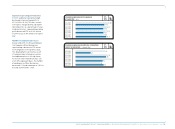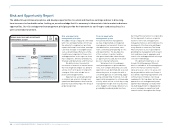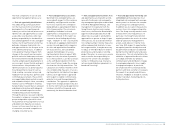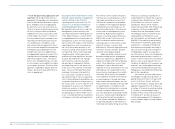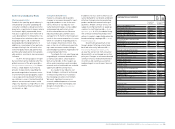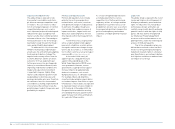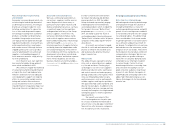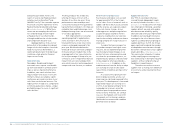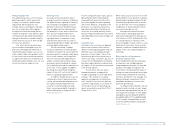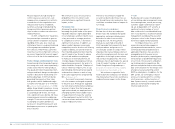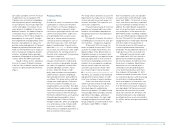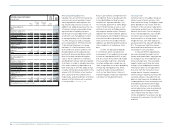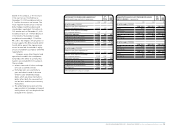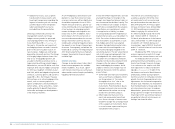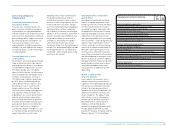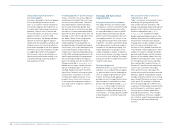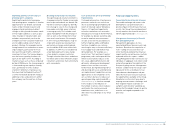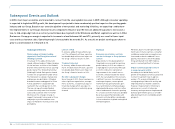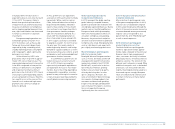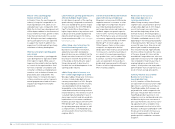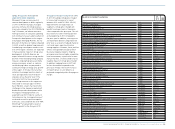Reebok 2009 Annual Report Download - page 153
Download and view the complete annual report
Please find page 153 of the 2009 Reebok annual report below. You can navigate through the pages in the report by either clicking on the pages listed below, or by using the keyword search tool below to find specific information within the annual report.
GROUP MANAGEMENT REPORT – FINANCIAL REVIEW Risk and Opportunity Report 149
Our target availability of 99.7% for major
IT applications was exceeded in 2009.
IT project risks are further mitigated by
utilising a proven project methodology
for all IT projects that includes tight cost
control and regular risk reviews for all
major projects. In addition to these fun-
damental controls, the adidas Group has
continued to focus on additional IT con-
trol initiatives in 2009. These include the
development of a five-year IT Strategic
Plan aligned with and approved by senior
business management, as well as the
periodic review and approval of IT project
budgets by a governance board. A new
team was formed within our IT organisa-
tion to manage all compliance-related
activities, including the phased imple-
mentation of Segregation of Duties (SOD)
controls within the ERP environment.
Based on these factors, we believe
the risk of a major IT default continues
to be low. Such a default, however, would
result in a significant potential financial
impact.
Financial Risks
Credit risks
A credit risk arises if a customer or other
counterparty to a financial instrument
fails to meet its contractual obligations.
The adidas Group is exposed to credit
risk from its operating activities and from
certain financing activities. Credit risks
arise principally from accounts receiv-
able and to a lesser extent from other
contractual financial obligations such as
other financial assets, short-term bank
deposits and derivative financial instru-
ments see Note 28, p. 194. Without taking
into account any collateral or other credit
enhancements, the carrying amount of
financial assets represents the maximum
exposure to credit risk.
At the end of 2009, there was no
relevant concentration of credit risk by
type of customer or geography. Instead,
our credit risk exposure is mainly influ-
enced by individual customer charac-
teristics. Under the Group’s credit
policy, new customers are analysed for
creditworthiness before standard pay-
ment and delivery terms and conditions
are offered. This review utilises external
ratings from credit agencies. Tolerance
limits for accounts receivable are also
established for each customer. Then both
creditworthiness and accounts receivable
limits are monitored on an ongoing basis.
Customers that fail to meet the Group’s
minimum creditworthiness are in general
allowed to purchase products only on
a prepayment basis. Other activities to
mitigate credit risks, which are employed
on a selective basis only, include credit
insurances, accounts receivable sales
without recourse and bank guarantees as
well as retention of title clauses.
The Group utilises allowance accounts for
impairments that represent our estimate
of incurred credit losses with respect to
accounts receivable. The allowance con-
sists of two components:
(1) an allowance based on historical
experience of unexpected losses estab-
lished for all receivables dependent on
the ageing structure of receivables past
due date, and
(2) a specific allowance that relates
to individually assessed risk for each spe-
cific customer – irrespective of ageing.
At the end of 2009, no Group cus-
tomer accounted for more than 10% of
accounts receivable. Nevertheless, the
negative impact of the deterioration of
the global economy on consumer confi-
dence and spending is not expected to be
reversed significantly in 2010 in view of
the still very challenging economic envi-
ronment. As a consequence, we believe
that our overall credit risk level from
customers, particularly smaller retail-
ers, remains high in several markets
see Economic and Sector Development, p. 112.
Therefore, our estimate of the likelihood
and potential financial impact of credit
risks from customers remains medium.
Credit risks from other financial
contractual relationships include items
such as other financial assets, short-
term bank deposits and derivative
financial instruments. The adidas Group
Treasury department arranges currency
and interest rate hedges, and invests
cash, with major banks of a high credit
standing throughout the world. adidas
Group companies are authorised to work
with banks rated “BBB+” or higher.
Only in exceptional cases are subsidiar-
ies authorised to work with banks rated
lower than “BBB+”. To limit risk in these
cases, restrictions are clearly stipulated
such as maximum cash deposit levels. In
addition, the credit default swap premi-
ums of our partner banks are monitored
on a weekly basis. In the event that the
defined threshold is exceeded, credit bal-
ances are shifted to banks compliant with
the limit. During 2009, the credit default
swap premiums for many banks declined
from their highs in the aftermath of
the financial turmoil in 2008, mainly as
a result of governmental intervention
worldwide. This development indicates a
slight decrease of the associated risks.
Although financial market condi-
tions stabilised in 2009, we continue to
believe that the likelihood and poten-
tial financial impact of credit risks from
these assets is medium. Nevertheless,
we believe our risk concentration is
limited due to the broad distribution
of our investment business with more
than 24 banks. At December 31, 2009,
no bank accounted for more than 19% of
our investment business and the average
concentration, including subsidiaries’
short-term deposits in local banks, was
1%. This leads to a maximum exposure
of € 158 million in the event of default of
any single bank. Furthermore, we held
derivatives with a positive fair market
value in the amount of € 55 million. The
maximum exposure to any single bank
resulting from these assets amounted to
€ 4 million and the average concentration
was 3%.


